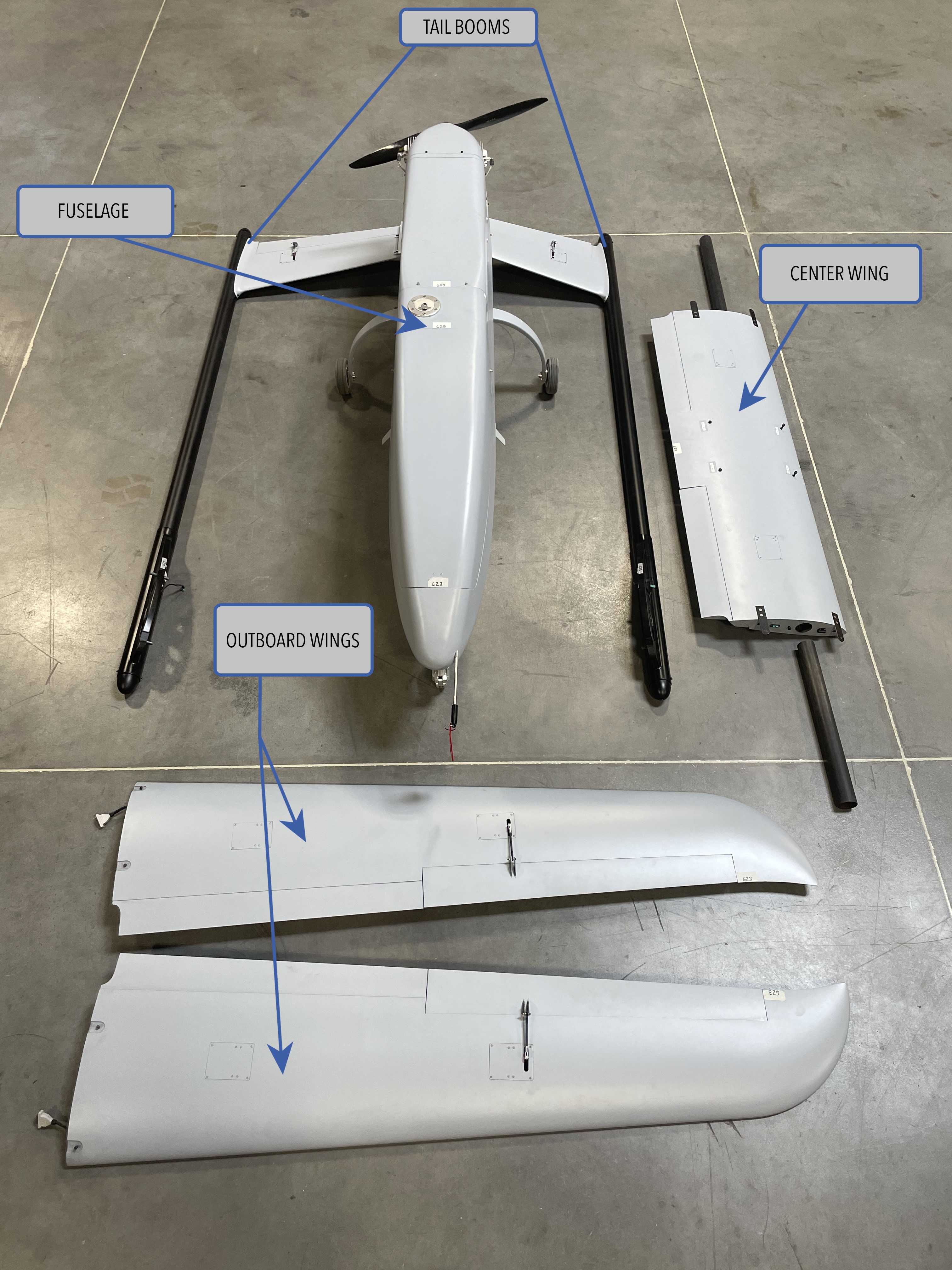Aircraft Overview
Falcon is a fully autonomous unmanned aerial system (UAS) designed and produced by SpektreWorks Inc. of Phoenix, Arizona, USA.
Falcon requires a minimum of two people to operate, but three is ideal. The crew typically consists of the operator, safety pilot, and ground personnel. The operator and ground personnel are essential while the safety pilot is optional. The safety pilot can double as the ground crew, and vice versa, if qualified.
Multiple dedicated payload bays and a 30 lb (13.6 kg) payload capacity allow to aircraft to perform various tasks such as ISR, mapping, communications relay, signals intelligence (SIGINT), and research.
The airframe is manufactured using lightweight carbon fiber and composite materials to achieve an optimal strength to weight ratio. The airframe and subcomponents have been tested successfully to withstand stress witnessed in normal flight conditions while retaining an ample safety margin. The main components of the airframe consist of the fuselage, booms, wings, and tails.
Fuselage: The Falcon fuselage is the main body of the airframe and contains the majority of electronics, including the autopilot, primary/secondary payload, and primary radio. The fuel tank sits within the fuselage, and the engine is attached to the rear of the fuselage.
Wings: The wings consists of a left and a right half. Each contain servo actuators for moving the ailerons, which control how the aircraft banks in flight. The inner sedtion of each wing contains a set of flaps which are controlled by servo actuators, controlling airspeed upon descent.
Booms: There is a left and right boom. Each boom contains half of the tail section.
This aircraft utilizes an "A" tail, having the two halves of the horizontal stabilizer form an "A" shape when assembled.
- Tail: There is a left and right tail section, each consisting of half of the "A" tail. Each half contains servo actuators for moving the rudder and elevator, which controls how the aircraft climbs and descends, and turns in flight.

Canopy: A quick-detachable canopy for accessing the payload and electronics within the fuselage.
Aileron: An aileron is a hinged flight control surface used to roll the aircraft in flight.
Rudder: The rudder is a hinged flight control surface used to yaw the aircraft in flight.
Elevator: The elevator is a hinged flight control surface used to climb and descend the aircraft in flight.
Pitot Tube: The pitot tube is a metal probe that extends beyond the nose of the aircraft. The pitot tube, combined with the airspeed sensor within the avionics, provides the aircraft with airspeed and wind information.
Servo: A servo is an electric actuator that moves a flight control surface. Sapphire has six servos in total, two for the left/right ailerons, two for the left/right elevators, and two for the left/right rudders.
Wing Servo: Servos for moving the ailerons.
Rudder Servo: Servos for moving the rudders.
Elevator Servo: Servos for moving the elevators.
LIDAR: The LIDAR rangefinder, which stands for light detection and ranging, measures the distance between the aircraft and the ground during landing.
Aircraft Specs
| Parameter | Specification |
|---|---|
| Empty Weight | 86 lbs |
| Max Gross Takeoff Weight (MGTOW) | 180 lbs |
| Fuel Capacity | 63 lbs (10.5 gal) |
| Payload Capacity | 30 lbs |
| Construction | Carbon fiber/composite |
| Wingspan | 16.5 ft / 5.0 m |
| Length | 11.5 ft / 3.5 m |
| Cruise Airspeed | 55 kts |
Engine Specs
| Parameter | Specification Carbureted | Specification EFI |
|---|---|---|
| Engine | Two-stroke Carbureted | Two-stroke Fuel Injected |
| Displacement | 9.15 ci (150 cc) | 9.15 ci (150 cc) |
| Continuous Power | 16.5 HP @ 6000 RPM | 16.5 HP @ 6000 RPM |
| Standard RPM Range | 2,500 - 7,000 RPM | 2,500 - 7,000 RPM |
| Fuel Type | 87-91 octane, C10 | 87-91 octane, C10 |
| Fuel Consumption | 7-8 lbs/hr (1.2-1.4 gal/hr) | 4-5 lbs/hr (0.66-0.83 gal/hr) |
| Endurance | 7.8 - 9 hr | 12.6 - 15.75 hr |
| Propeller | 30 x 12 | 30 x 12 |
Vehicles equipped with EFI engines utilize an alternator to maintain battery charge. Please note if the payload system operates continuously and may contribute to increased fuel consumption, lowering the flight time to be less then the 12.6 - 15.75 hr.